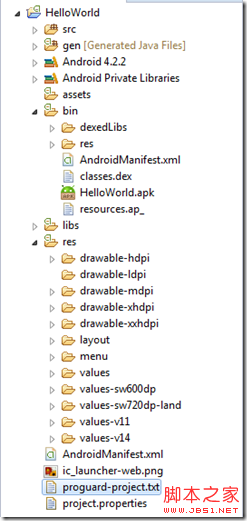編輯:Android開發實例
本文實例介紹的Android的Gallery控件是個很不錯的看圖控件,可以大大減輕開發者對於看圖功能的開發,並且效果也很美觀。本文實例中的Gallery的用法,主要實現用反射機制來動態讀取資源中的圖片。
該實例代碼運行的效果圖如下:

main.xml源碼如下:
<?xml version="1.0" encoding="utf-8"?> <LinearLayout xmlns:android="http://schemas.android.com/apk/res/android" android:orientation="vertical" android:layout_width="fill_parent" android:layout_height="fill_parent" > <Gallery android:id="@+id/gallery" android:layout_height="fill_parent" android:layout_width="fill_parent"></Gallery> </LinearLayout>
Java程序源碼如下:
package com.testImageView;
import java.lang.reflect.Field;
import java.util.ArrayList;
import android.app.Activity;
import android.content.Context;
import android.graphics.Bitmap;
import android.graphics.BitmapFactory;
import android.os.Bundle;
import android.view.View;
import android.view.ViewGroup;
import android.widget.AdapterView;
import android.widget.BaseAdapter;
import android.widget.Gallery;
import android.widget.ImageView;
import android.widget.AdapterView.OnItemClickListener;
public class testImageView extends Activity {
private Gallery mGallery;
@Override
public void onCreate(Bundle savedInstanceState) {
super.onCreate(savedInstanceState);
setContentView(R.layout.main);
mGallery = (Gallery)findViewById(R.id.gallery);
try {
mGallery.setAdapter(new ImageAdapter(this));
} catch (IllegalArgumentException e) {
// TODO Auto-generated catch block
e.printStackTrace();
} catch (IllegalAccessException e) {
// TODO Auto-generated catch block
e.printStackTrace();
}
mGallery.setOnItemClickListener(new OnItemClickListener() {
public void onItemClick(AdapterView parent, View v, int position, long id) {
testImageView.this.setTitle(String.valueOf(position));
}
});
}
/*
* class ImageAdapter is used to control gallery source and operation.
*/
private class ImageAdapter extends BaseAdapter{
private Context mContext;
private ArrayList<Integer> imgList=new ArrayList<Integer>();
private ArrayList<Object> imgSizes=new ArrayList<Object>();
public ImageAdapter(Context c) throws IllegalArgumentException, IllegalAccessException{
mContext = c;
//用反射機制來獲取資源中的圖片ID和尺寸
Field[] fields = R.drawable.class.getDeclaredFields();
for (Field field : fields)
{
if (!"icon".equals(field.getName()))//除了icon之外的圖片
{
int index=field.getInt(R.drawable.class);
//保存圖片ID
imgList.add(index);
//保存圖片大小
int size[]=new int[2];
Bitmap bmImg=BitmapFactory.decodeResource(getResources(),index);
size[0]=bmImg.getWidth();size[1]=bmImg.getHeight();
imgSizes.add(size);
}
}
}
@Override
public int getCount() {
// TODO Auto-generated method stub
return imgList.size();
}
@Override
public Object getItem(int position) {
// TODO Auto-generated method stub
return position;
}
@Override
public long getItemId(int position) {
// TODO Auto-generated method stub
return position;
}
@Override
public View getView(int position, View convertView, ViewGroup parent) {
// TODO Auto-generated method stub
ImageView i = new ImageView (mContext);
//從imgList取得圖片ID
i.setImageResource(imgList.get(position).intValue());
i.setScaleType(ImageView.ScaleType.FIT_XY);
//從imgSizes取得圖片大小
int size[]= new int[2];
size=(int[]) imgSizes.get(position);
i.setLayoutParams(new Gallery.LayoutParams(size[0], size[1]));
return i;
}
};
}
 Android加載Spinner
Android加載Spinner
可以顯示在的Android任務,通過加載進度條的進展。進度條有兩種形狀。加載欄和加載微調(spinner)。在本章中,我們將討論微調(spinner)。Spinner 用
 listview改變字體大小實例講解
listview改變字體大小實例講解
效果:點擊字體,字體變大 主要利用的getView()方法和setOnItemClickListener()方法 ListText.java 代碼如下: pack
 Android 初識 Helloworld 詳解
Android 初識 Helloworld 詳解
HelloWorld的目錄結構有: src:存放應用程序的邏輯代碼,這裡面的代碼是人工寫的gen:存放資源代碼,這裡面的代碼是自動生成的assets:存放mp
 android:descendantFocusability方法介紹
android:descendantFocusability方法介紹
此方法適用於所有母控件無法獲取焦點的情況 開發中很常見的一個問題,項目中的listview不僅僅是簡單的文字,常常需要自己定義listview,自己的Adapte